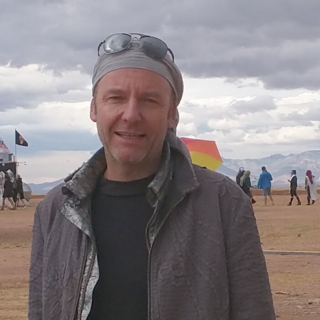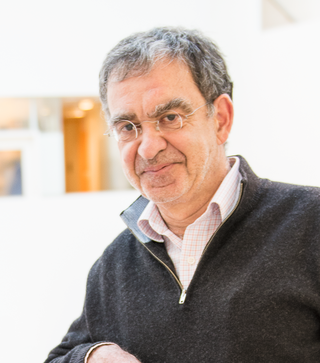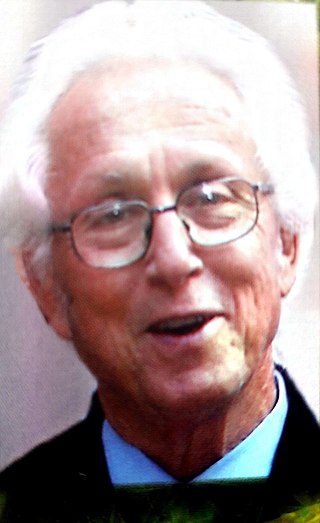The consciousness and binding problem is the problem of how objects, background and abstract or emotional features are combined into a single experience.
Terrence Joseph Sejnowski is the Francis Crick Professor at the Salk Institute for Biological Studies where he directs the Computational Neurobiology Laboratory and is the director of the Crick-Jacobs center for theoretical and computational biology. He has performed pioneering research in neural networks and computational neuroscience.

A neural network is a neural circuit of biological neurons, sometimes also called a biological neural network, or a network of artificial neurons or nodes in the case of an artificial neural network.

Stephen Grossberg is a cognitive scientist, theoretical and computational psychologist, neuroscientist, mathematician, biomedical engineer, and neuromorphic technologist. He is the Wang Professor of Cognitive and Neural Systems and a Professor Emeritus of Mathematics & Statistics, Psychological & Brain Sciences, and Biomedical Engineering at Boston University.

The Gottfried Wilhelm Leibniz Prize, or Leibniz Prize, is awarded by the German Research Foundation to "exceptional scientists and academics for their outstanding achievements in the field of research". Since 1986, up to ten prizes have been awarded annually to individuals or research groups working at a research institution in Germany or at a German research institution abroad. It is considered the most important research award in Germany.
Computational auditory scene analysis (CASA) is the study of auditory scene analysis by computational means. In essence, CASA systems are "machine listening" systems that aim to separate mixtures of sound sources in the same way that human listeners do. CASA differs from the field of blind signal separation in that it is based on the mechanisms of the human auditory system, and thus uses no more than two microphone recordings of an acoustic environment. It is related to the cocktail party problem.

Michelle Anne Mahowald was an American computational neuroscientist in the emerging field of neuromorphic engineering. In 1996 she was inducted into the Women in Technology International Hall of Fame for her development of the Silicon Eye and other computational systems. She committed suicide at age 33.
Neurophysics is the branch of biophysics dealing with the development and use of physical methods to gain information about the nervous system. Neurophysics is an interdisciplinary science using physics and combining it with other neurosciences to better understand neural processes. The methods used include the techniques of experimental biophysics and other physical measurements such as EEG mostly to study electrical, mechanical or fluidic properties, as well as theoretical and computational approaches. The term "neurophysics" is a portmanteau of "neuron" and "physics".

Hartmut Neven is a scientist working in quantum computing, computer vision, robotics and computational neuroscience. He is best known for his work in face and object recognition and his contributions to quantum machine learning. He is currently Vice President of Engineering at Google where he is leading the Quantum Artificial Intelligence Lab which he founded in 2012.

Tomaso Armando Poggio, is the Eugene McDermott professor in the Department of Brain and Cognitive Sciences, an investigator at the McGovern Institute for Brain Research, a member of the MIT Computer Science and Artificial Intelligence Laboratory (CSAIL) and director of both the Center for Biological and Computational Learning at MIT and the Center for Brains, Minds, and Machines, a multi-institutional collaboration headquartered at the McGovern Institute since 2013.

Yann André LeCun is a Turing Award winning French computer scientist working primarily in the fields of machine learning, computer vision, mobile robotics and computational neuroscience. He is the Silver Professor of the Courant Institute of Mathematical Sciences at New York University and Vice-President, Chief AI Scientist at Meta.

Daniel J. Amit Hebrew: דניאל עמית was an Israeli physicist and pacifist, who was one of the pioneers in the field of computational neuroscience. Amit, Hanoch Gutfreund and Haim Sompolinsky, in a set of papers referred to as the ASG papers, were the first to demonstrate the utility of statistical mechanics in neural network research and helped establish theoretical and computational neuroscience as a novel approach that brings into brain research unique powerful sets of concepts, models, and standards of rigour.
The Bernstein Network is a research network in the field of computational neuroscience; this field brings together experimental approaches in neurobiology with theoretical models and computer simulations. It unites different scientific disciplines, such as physics, biology, mathematics, medical science, psychology, computer science, engineering and philosophy in the endeavor to understand how the brain functions. The close combination of neurobiological experiments with theoretical models and computer simulations allows scientists of the Bernstein Network to pursue innovative approaches with regard to one of the most complex structures nature has created in the course of evolution: the natural brain.
Laurence Frederick Abbott is an American theoretical neuroscientist, who is currently the William Bloor Professor of Theoretical Neuroscience at Columbia University, where he helped create the Center for Theoretical Neuroscience. He is widely regarded as one of the leaders of theoretical neuroscience, and is coauthor, along with Peter Dayan, on the first comprehensive textbook on theoretical neuroscience, which is considered to be the standard text for students and researchers entering theoretical neuroscience. He helped invent the dynamic clamp method alongside Eve Marder.
Newton Howard is a brain and cognitive scientist, the former founder and director of the MIT Mind Machine Project at the Massachusetts Institute of Technology (MIT). He is a professor of computational neurology and functional neurosurgery at Georgetown University. He was a professor of at the University of Oxford, where he directed the Oxford Computational Neuroscience Laboratory. He is also the director of MIT's Synthetic Intelligence Lab, the founder of the Center for Advanced Defense Studies and the chairman of the Brain Sciences Foundation. Professor Howard is also a senior fellow at the John Radcliffe Hospital at Oxford, a senior scientist at INSERM in Paris and a P.A.H. at the CHU Hospital in Martinique.
Klaus-Robert Müller is a German computer scientist and physicist, most noted for his work in machine learning and brain–computer interfaces.
Thomas Martinetz is a German physicist and neuro-informatician.

Kanaka Rajan is a computational neuroscientist in the Department of Neurobiology at Harvard Medical School and founding faculty in the Kempner Institute for the Study of Natural and Artificial Intelligence at Harvard University. Rajan trained in engineering, biophysics, and neuroscience, and has pioneered novel methods and models to understand how the brain processes sensory information. Her research seeks to understand how important cognitive functions — such as learning, remembering, and deciding — emerge from the cooperative activity of multi-scale neural processes, and how those processes are affected by various neuropsychiatric disease states. The resulting integrative theories about the brain bridge neurobiology and artificial intelligence.
Tatjana Tchumatchenko is a physicist in the field of theoretical neuroscience. She is an independent Max Planck Group Leader and, since November 2020, professor for Computational Neuroscience of Behavior at the Faculty of Medicine of the Rheinische Friedrich-Wilhelms-Universität Bonn (Germany). In her research she investigates how neural networks compute and how particular activity patterns emerge from synaptic and neuronal features.
Gregor Schöner is a German computational neuroscientist. He is professor for the theory of cognitive systems at the Ruhr University Bochum, as well as the director of the Institute for Neuroinformatics located there.









